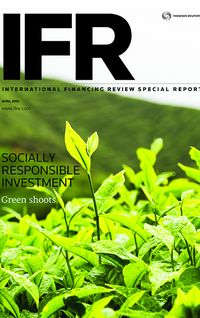China and India are seeking to tap pools of environmentally conscious capital as regulators work to build a primary market framework. But it is not a straightforward proposition for issuers, as primary Green bonds have yet to show a discrete pricing advantage.
According to the Climate Bonds Initiative, Green bond issuance totalled US$42.4bn last year, an increase of almost 16% from the US$36.6bn that printed in 2014. Data from Thomson Reuters show exponential growth in supply from Asia-Pacific, with US$498m issued in 2013, US$538m in 2014, US$2.8bn in 2015 and US$8.4bn so far this year.
“As far as Green bonds and the ESG agenda are concerned, 2016 is shaping up to be a pivotal year. Initiatives such as the Financial Stability Board task force on climate-related financial disclosures, chaired by Michael Bloomberg, are beginning to be effective in developing voluntary, consistent climate-related financial risk disclosures for the use by companies in providing information to investors, lenders, insurers and other stakeholders,” said Ulrik Ross, global head of public sector and sustainable financing at HSBC in London.
The underlying motivation for the development of the Green bond market is concern about global climate change, which has become a major priority for those governments that signed the Kyoto protocols on climate change in 1997. And the signing of the COP21 climate change agreement in Paris last December only adds to the natural consequent forward thrust to Green bond issuance.
“We believe that the new guidelines will find their way into national regulation and stock exchange listing requirements that are aligned with the official policy agenda. Increased climate-related disclosure is a new norm and we believe the real impact will be seen in 2017 and onwards,” said Ross.
Broadly, the development of the Green bond sector has followed a clear dynamic globally: the multilateral institutions such as the International Finance Corp or the European Investment Bank have opened the market with inaugural benchmark deals. Then other development banks – using Asia as an example – such as the Export-Import banks of South Korea and India have followed. Finally, the commercial banks have tapped, with notable deals in Asia from China and India seen over the past few years from the likes of Agricultural Bank of China and Yes Bank.
Industry professionals in the field of environmental, social and corporate governance (ESG) investment are hoping that the Green bond market develops further depth in the form of issuance from corporates and that the lower reaches of the credit curve can be tapped by the emerg ence of a high-yield market.
Baby steps
Baby steps were taken towards the opening up of this sector in Asia by Taiwan’s Advanced Semiconductor Engineering in 2014, which priced the region’s first pure corporate Green bond. And, in March, South Korea’s Hyundai Capital Services gave a further taste of things to come by issuing a US$500m Reg S/144a five-year.
Certainly, the momentum is there: given estimates that for the targets of the COP21 agreement to be met, around US$53trn must be invested by 2050 in assets which comply with globally accepted ESG criteria, it seems a necessity that the development of the corporate high-yield Green bond market occur.
“Green bonds are certainly gaining recognition in Asia but the maturity of the sector is still some way off. For investors, Green bonds offer to meet environmental, social and corporate governance investment principles, and, for issuers, being ‘green’ opens up a new universe of investors but with little price incentive,” said Jake Gearhart, head of debt syndication and origination for Asia Pacific at Deutsche Bank in Singapore.
“The overall challenge, though, is the sustainability setting, monitoring and developing green standards for issuers and investors.”
As far as Asia is concerned, the most fertile source of Green bond issuance over the next decade is likely to be China and India.
India has vast infrastructure needs, and the administration of prime minister Narendra Modi, which is barely two years old, has openly staked its reputation on building the country’s sorely wanting infrastructure, with the ambition to anchor growth in the power sector in renewables.
For global investors, this is being marketed as an opportunity to participate in the India growth story, but there are considerable challenges in terms of the overhand of leverage in the infrastructure sector and challenges with offtake agreements with local power providers. The Indian Green bonds sector printed US$847m-equivalent in 2015, which was the inaugural year for the product out of the country.
India’s domestic banks have been traditionally the country’s biggest providers of infrastructure financing, and they are sitting on a pile of bad debt, largely in the form of poorly structured loans. Meanwhile, local infrastructure sponsors face damaged balance sheets thanks to underperforming legacy projects which constrain the ability to develop new infrastructure.
It is therefore indubitable that the Indian infrastructure market presents a pressing case of the need for disintermediation towards the bond market – and to this end, the green product sits naturally as the investment vehicle of choice.
“The most likely prime mover as far as Green bond issuance is concerned in India will be Project bonds. India’s long-standing reliance on coal-fired power has left a bitter taste in the form of cost overruns, a failure by local power providers to honour offtake agreements and cost overruns. Hence, it’s no surprise that renewable energy is now seen as the only way to go. Construction lead-in times for solar and wind power are relatively short, meaning short-tenor Green bonds in project format are an ideal funding vehicle,” said a Mumbai-based project finance banker.
Last year, Deutsche Bank estimated in a report that over the next six years India will become one of the world’s biggest producers of renewable energy. Modi has set a target for the generation of 100GW of wind-generated power by 2022, a near five-fold increase from the current 22.5GW. The same power-generation target has also been set for the solar sector.
Around a dozen-odd Indian infrastructure companies are rumoured to be eyeing the Project bond market, and it might well be that the opening up of the corporate sector for Green bond issuance out of the country awaits.
The Export-Import Bank of India blazed a trail for Green bond issuance from the country in early 2015 with a deal that managed to surprise the bank’s treasurers, given the hefty demand that allowed it to be upsized to US$500m from a planned US$250m–$300m.
But in the process, the issue highlighted the hurdles potential Green bond issuers must confront before tapping the market. India Exim’s primary purpose in issuing the bond was to diversify its investor base, and there is no doubt that tapping into the deep pool of ESG-conscious capital – which sits largely in Scandinavia and the US – offers this opportunity.
Nevertheless, the cost of seeking a second opinion on a Green bond’s compliance can often prove a major turn-off for potential issuers. And there is – for now at least – no significant cost-saving in spread terms presented by taking the green rather than the conventional issuance route, leaving investor diversification as the single most obvious reason for “going green”.
On the other hand, the multi-lateral development banks can prod potential issuers in the direction of Green bond issuance through the provision of credit wraps which facilitate market entry for mid-sized corporates. In India, last July, wind energy producer ReNew issued with wraps from the Asian Development Bank and the IFC and was able to tap maturities as long as 18 years.
While issuance came in conventional format, it was significant, given that issuance beyond five years in India’s illiquid domestic bond market is a rarity.
The recent adoption of a new mission statement by the World Bank in which it added climate change to its traditional mission to reduce poverty, and the likelihood that other multi-lateral development banks will similarly tweak their mission statements, the credit wrap is an obvious choice to become a significant element in the growth dynamic of Green bonds in the emerging markets.
China joining apace
China has been late to the Green bond party, but, as the world’s largest emitter of greenhouse gases, there is no more obvious participant. It seems that in 2013 the country’s authorities “got the joke” about climate change and that year the State Council announced plans to fund environmentally friendly industries via debt. As current chair of the G20 group of nations, China is also taking the lead in the environmental stakes.
“China has picked up the ball when it comes to the green agenda, and the People’s Bank of China and the National Development and Reform Commission have established a framework around Green bond issuance, comprising basic definitions and quotas,” said HSBC’s Ross.
A surge in impetus towards the emergence of a Green bond market in China came last December, when the National Development and Reform Commission issued regulations to promote Green bond issuance, targeting 12 industrial sectors.
Borrowing and use of proceeds requirements were relaxed, including a 10% loosening on the cap for the use of proceeds and a provision that up to 50% of proceeds can be used to repay bank loans, again illustrating the handiness of Green bonds in the disintermediation dynamic. And again, as is the case with India, China is prioritising the production of renewable energy, setting aside around US$2.5trn to be invested in the sector over the next 15 years.
The country made addressing climate change central to its latest five-year plan, passed at the National People’s Congress in March. The development of a green financial system is axiomatic to this plan and the issuance of Green bonds a central tenet. A green rating system, stock index and carbon trading are all in the works. Moreover, the People’s Bank of China is the co-chair of a green finance study group with the Bank of England.
In October, Agricultural Bank of China priced the country’s first Green bond, a US$995m-equivalent bond issued in dollars and offshore renminbi. China’s other big lenders – Bank of China, Industrial and Commercial Bank of China and China Construction Bank – are expected to follow suit, and once the benchmarking is done, China’s state-owned enterprises are expected to issue en masse.
“Going forward, the potential for governments to give tax breaks to Green bond issuers is the touch-paper. If that happens, we expect to see a huge growth in Green bond issuance,” said Ross.
To see the digital version of this special report, please click here
To purchase printed copies or a PDF of this report, please email gloria.balbastro@thomsonreuters.com



